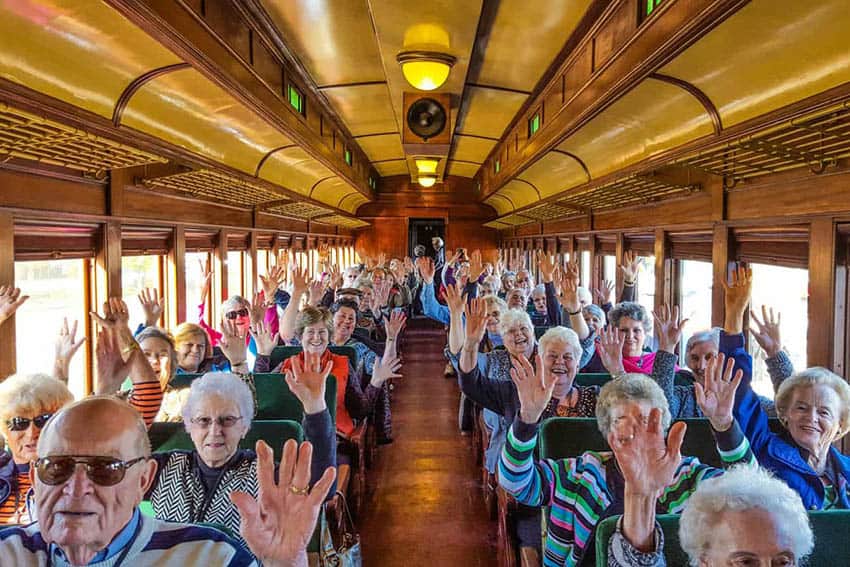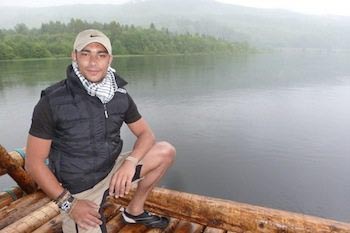The Cotahuasi River Is Rafting Heaven
By Jess Tuerk

I never considered myself an adventure traveler until I got to Peru, where even a short bus trip can turn into an adventure – roadblocks, llamas, livestock, rocky cliffs, flat tires and all.
I always considered myself a part of the more mainstream backpacker crowd – Lonely Planet in hand – as I explored Maccu Picchu, Cusco, Lima, and the Nazca Lines.
But tired of this predictable “gringo trail” of sights throughout South America, I signed on with an Ariquippenan rafting company to float down the class IV and V Cotahuasi River 70 miles, along ancient Incan footpaths and untouched archeological sites and remote villages, until it empties into the Pacific Ocean near Ica.

The only problem? I had never set foot in a raft before.
His sun-reddened face looked tired but it was lit with excitement, like the face of an expectant child on Christmas Day. His shoulder-length blond hair was wild and tangled.
“The Cotahuasi River is higher than it has been in ten years,” I heard Peruvian river guide Gian Marco Vellutino remark in his Spanish-Italian accent as he gazed over the cactus-lined edge of a ravine that dropped 50 feet down to a very white, and very fast river.
“Coootaaaahuasseeeee!” he shouted, wildly waving his arms out to the side and looking to me to echo some of that enthusiasm back.
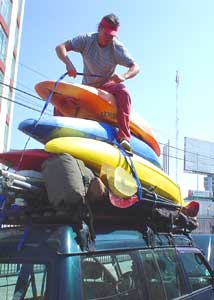
I was not as excited. In fact, I was downright scared.
Vellutino waited weeks for river levels to subside enough to safely paddle, and the time had finally arrived – but barely. It was as if the energy of the forceful Cotahuasi has recharged his body.
I, however, was feeling sick to my stomach and was gravely reconsidering how it was that I got talked into a Class IV and V river at the bottom of the deepest raftable canyon in the world to serve as my first river trip experience.
We had arrived in the darkness of night at our dusty campsite just hours before. I had started the journey in the white-washed town of Arequipa and traversed by van, piled high with four kayaks, raft, oar rigs, food, and gear, through the cold and starry night over the Atacama.
I sleeplessly bumped along the unpaved roads for 12 hours, accompanied by Vellutino, our shotgun-toting driver, a first-time raft guide, and three adventurous American kayakers.
In the morning, I limp over to breakfast, which is sitting out on the vinyl camp table, stiff and aching.
I was prodded from my rented sleeping bag at dawn by strange and fuzzy “digger bees.” The smallish, biting, insects started to crawl out of their mud holes in the ground at sight of the light of day, and as it happened, I had made my bed atop a colony of thirty or forty of these tiny holes.
Touching my swollen and bee-stung ankle, it occurs to me that I might not make it out of this expedition intact – or even alive.
High Stakes Adventure
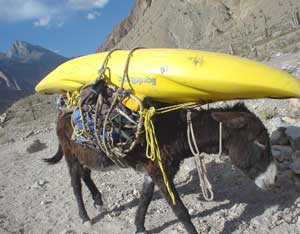
In May 2000, a 36-year-old British adventure travel journalist — like myself, perhaps simply yearning for a good story and unique adventure — was ejected from her raft above a Class V rapid, and her body was never recovered.
The 2000 expedition faced a combination of higher-than-expected water, poor judgment and bad luck. Could our party also fall victim to these circumstances? Was I, the inexperienced, young, female rafter amongst four stronger and river-savvy kayakers the Cota’s next probable victim?
One thing I knew for sure from my solo travels abroad was never to discount the emergency situation potentially lurking around every corner. As I finished chewing my lumpy oatmeal I swallowed hard at the thought.
A Geological Wonderland
The Cotahuasi is to river-enthusiasts what Everest is to adventure climbers — a Holy Grail of superlative expeditions. My guide, Vellutino, and a group of four Americans made its first descent in 1994 after it was proven that it was, at a depth of 3,501 m (11,488 ft), indeed the deepest raftable canyon in the world.

Much like the Grand Canyon (1,600 meters), the river carves through the bottom of a spectacular desert canyon. Unlike the Colorado, however, a trip down the Cotahuasi takes you to territory so remote and unexplored — complete with unexcavated pre-Incan and Incan ruins gracing the canyon walls — that more visitors have actually summitted Everest than have navigated the Cotahuasi River.
It was declared the deepest river canyon on the face of the planet in 1991 at just shy of 3600 meters deep – more than twice the depth of the Grand Canyon.
It is remote, even for Peruvian standards. During the Incan Empire, the people of the Cotahuasi dodged conquistador rule for 100 years beyond natives in nearby towns like Arequippa and Cusco, due to its isolation.

The people in this valley depended then, as they still do, on Rio Cotahuasi´s geography as a route from the mountains all the way into the Pacific Ocean.
The 80-kilometer stretch of canyon hosts narrow dirt trails up and down the sides of the canyon, creating a trade route that connects small villages like Chuquibamba and Iquipe.
The Route To the Put-In: A Trail Less Traveled
We could not begin our river journey yet — first, we would need to hike from this campsite near the village of Cotahuasi along an ancient Incan highway for 14 kilometers, up and over and around desert canyons and sheer walls that reveal the geologic history of millions and millions of years.
I would have the day to walk in the hot Atacama sun and meditate on the journey on which I had embarked.
Locals helped up to load all our gear onto the backs of burros, which would shadow us on our long and difficult hike to the put-in.
Breaking in My River Legs
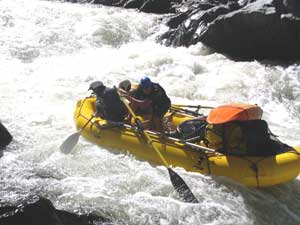
The first time I ever climbed into a dry top and life vest turned out to be minutes before I actually put them to use. After a morning of river safety training, I climbed into the behemoth yellow raft shaking with nerves.
My respect for this river was great, and I was excited to start only so that I would sooner be at peace on the Pacific Ocean. The raft guide, Sergio, as it turned out, was also nervous as we started out, and cursed quite frequently as we hit what he declared to be “giant mother holes.”
My nerves probably played a part in my being bumped out of the raft within the first hour of our journey – an experience that taught me to fend for myself and to hold on tighter than I ever thought I could.

At their least powerful, these giant mother holes of the Cotahuasi would suck our raft in and churn us around and around in their frothy tide. At their most powerful, they could flip our raft – the consequences I did not have the courage to play out in my mind.
Working Together
After my near-disaster swim in the river, Sergio and I learn fast to work together. I learn how to use my oar effectively and powerfully to proper us one way or the other. By the time we emerged from some “class IV plus” rapids, I find I am drenched in both water and adrenaline and holding my breath.
But as the white river trailed off behind our yellow raft, I relaxed and realized that I had made it to the bottom of this multi-layered, rocky canyon gorge. As I looked up at the horizontal red layers of earth, I smiled to myself at its beauty.

But on the Cota, the rapids are virtually continuous, and the peaceful breaks in between gut-wrenching holes are shorter than I would have hoped. The journey quickly baptized me into the word of rafting — my front and back paddle strokes became familiar and automatic.
When my arms and stomach burned from exhaustion, I paddled harder to get us through the next rapid more easily. When we careened up onto giant river rocks, I flung my body high sides as fast as possible to avoid a flip. When we eddied out, I jumped ashore to pull the heavy leviathan of a raft, always thankful for the opportunity to eat a meal or sleep along this remote route.
Untouched Archaeological Ruins
On three occasions, it was necessary for me to hike up and over a pass where the river ran unraftable – too narrow, too steep, too dangerous. All along the journey down the river had run visible terraced Incan walls, low stacks of stones up onto the sides of the canyon.
Meandering through the Ruins
The portages allowed me the once in a lifetime opportunity to meander among the ruins themselves and explore abandoned Incan sites. On one portage, I explored the lost city of Marpa, discovering burial sites, houses, irrigation systems, and stone stairways.
At night, I slept under the starry sky on the once-farmed terraces of a long-ago civilization and dreamed of the powerful river that would at once be both my nightmare and my deliverance to the sea.
Passage to the Pacific
On the fifth day of the river journey, one last giant rapid remained – the aptly-nicknamed High Side for Your Life rapid, before class III rapids would carry us all the way out to the confluence with the Moran River, where the Cotahuasi’s rage seemed to dispel.
Naked village boys stood by the river’s edge setting their conical shrimp traps and waving quizzically at the strange sight of our colorful flotilla as we passed. As the river flattened out even more, I paddled harder with my arms, straining and burning with every last stroke. I could do anything now. I had survived my adventure in Peru, off the gringo trail.
Flights to Arequipa, Peru, leave from Lima daily on Wayra, and LAN airlines ($70-$100). Cusipata.com – The only company that runs tours down the Cotahuasi and nearby Colca Rivers.
 Jess Tuerk is an educator and freelance writer based out of Eugene, Oregon. She likes getting off the beaten path. View her travel blog Life in 2D.
Jess Tuerk is an educator and freelance writer based out of Eugene, Oregon. She likes getting off the beaten path. View her travel blog Life in 2D.
- These 9 U.S. National Parks Require Reservations in 2024 - April 17, 2024
- Take a Hike in Olympic National Park - April 17, 2024
- The Wild Mississippi: 2340 Miles Across Ten States - April 8, 2024



